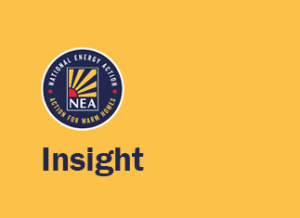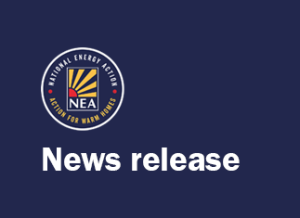By Jess Cook, Project Development Manager, Water Poverty Unit
Please complete the survey between 16-27 November |
Water is unquestionably essential to all aspects of life, and so it is vitally important that all households are supported to ensure they have access to safe, clean and affordable water – something which the United Nations recognise as a human right. Although access issues to safe and clean water are rare in the UK, unfortunately, affordability issues are not.
The longer-term financial impacts of the Covid-19 crisis are now starting to be realised. In a relatively short space of time, households previously managing their finances now find themselves in a wilderness of debt, struggling and spiralling deeper and deeper into difficulty. Finances have been hit hard and hit quickly, and no-one knows when their situation might improve.
Since March 2019, NEA has been working to raise awareness of water poverty in the UK, seeking to align the policy and practical action required to support water poor households, with the goal of eradication by 2030. Our work programme is built on four key pillars:
Measuring Water Poverty
Despite numerous projects across the industry working to ‘eradicate’ water poverty, the industry is yet to agree on a common measurement of water poverty. Various measurements are used by the 17 regulated water companies in England and Wales, including bill-to-income ratios of 2%, 3% and 5% of household disposable income (after housing costs), and more subjective measurements such as whether or not a household deems their bill to be ‘affordable’.
Regardless of measurement, CCW estimate that 12% of households find their combined water and sewerage bill to be ‘unaffordable’, and so significant action is required to help those low-income households struggling to afford this essential service.
NEA recommends a common measurement be agreed and adopted by all water companies by the start of the next price control period (2025) alongside a measurement of the ‘water poverty gap’ to understand the depth of the issue. This does not prevent activity to mitigate the impacts of water poverty taking place now as this can still be targeted to the households most in need.
Charging and Financial Support
The two most important factors in determining whether a household is in water poverty are the cost of water and sewerage services (i.e. the combined bill) and the household income. If bills reduce, or incomes increase, then households could potentially move out of water poverty. There is limited scope to influence incomes, other than income maximisation advice and benefits entitlement checks, but water companies and regulators have more flexibility when it comes to bills.
There are only two current charging mechanisms: measured, and unmeasured[i]. Household customers therefore are extremely limited in their tariff options, and so innovation in this area should be encouraged. Low-income households do have additional tariff options available to them: WaterSure for metered households in receipt of an income-related benefit and who use additional water for medical needs or have three or more children; and, social tariffs which offer discounts/bill-caps based on company-specific eligibility criteria and support levels.
NEA has called for a full review of social tariff guidance, funding, eligibility and support levels to ensure that, regardless of where they live, all customers have fair access to support as needed.
Debt
In recent years there has been a substantial shift in trends related to personal debt. Households accessing debt support are now more likely to present with smaller, trickier to manage debts, such as household arrears, whereas a decade ago it was more likely to be credit cards and loans.
Since the Water Industry Act (1999) domestic water supply cannot be disconnected or restricted due to arrears, meaning the consequences of non-payment are deemed to be lower in water when compared to other sectors’ practices. Although not always the case, water is therefore often the first bill customers default on, and as a result, reported debt levels in the water industry are more than double those seen in energy (last reported as £2.2bn in 2017)[ii].
In our recent discussion paper, ‘Surviving the Wilderness: the landscape of personal debt in the UK’[iii], we put forward a number of key recommendations to assist households in urgent need of support with their debt and arrears following the Covid-19 crisis, including proposals for increased data sharing, debt support funding from UK Government, and a definition of ‘severe indebtedness’ to help prioritise those in the worst situations.
Water Efficiency
Outside of household incomes and bill profiles, water efficiency measures also have the ability to save customers money, albeit at a lower level than the potential savings in energy efficiency. When delivered alongside education on how to better use water in the home, there is evidence of customer benefit and savings, especially when focused on the efficient use of hot water as they also benefit from the associated energy savings.
Customers must have a water meter in order to benefit from the financial savings of water efficiency measures, but unfortunately those on a water meter will have been detrimentally impacted by increased water charges due to spending more time at home during the Covid-19 lockdown. It is therefore extremely important that a balance is found to avoid giving water metering a bad name.
Saving water also has substantial environmental benefits. Sir James Bevan, Chief Executive of the Environment Agency, highlighted that we are heading towards the ‘jaws of death’ where, in 25 years, we will no longer have the water available to meet our needs. Efficient use of water is therefore extremely important if we are to avoid price increases being used as a tool for sustainable water use.
In October 2020, CCW launched a full review of water affordability support at the request of UK and Welsh Government, which is due to publish findings in Spring 2021. This follows NEA’s call[iv] for a full review of social tariff guidance, funding, eligibility, and support levels in June 2020; the review will look at social tariffs, but also at other financial support available across the industry and identify opportunities to improve the support offered to financially vulnerable households and this is a welcome development. It will be guided by a panel of experts and informed by two independently delivered pieces of research: the first will undertake a series of in-depth interviews with low-income households, and the second will review cross-sector approaches to effective engagement of customers in affordability support initiatives. Alongside this, stakeholders can provide their views by attending one of a series of stakeholder events, and by submitting a response to an open call-for-evidence.
One of the most utilised forms of support to help customer struggling with the impact of the Covid-19 crisis has been payment holidays, with over 3.5 million requests for mortgages, credit cards and loans, and thousands for household utility bills. While these breaks offer a short-term reprieve from the financial commitment, the debt is still owed and interest can still accrue, therefore they are not a sustainable option in the long-term. This accumulated debt will be placing even more pressure on the households who have accessed payment breaks from numerous providers, and support to help them clear this debt will be required.
In the very early days of the crisis, the water industry announced a consistent set of measures to support customers experiencing financial difficulty due to Covid-19. One such measure was the extension of support offered under existing financial schemes and support tariffs[v]. Our June 2020 short paper, ‘Social Tariffs in Water: The Impact of Covid-19’[vi] accompanied the longer social tariff discussion paper and expanded on the issues outlined in the context of the Covid-19 crisis. This included highlighting the postcode lottery created by the differences in eligibility criteria and support levels of social tariffs, and the limited amount of scope in the funding agreed under customer cross-subsidies to fund additional support.
While this affordability review is an excellent step forward, to ensure that the measures and recommendations are acted upon, NEA recommend UK Government should set out a water poverty strategy and a statutory target to eliminate water poverty by 2030. This should be accompanied by a Vulnerability strategy and accompanying Vulnerability Principle licence condition[vii], set out by Ofwat, to ensure all company values are aligned.
NEA will continue to support the water industry to develop further understanding of the issues faced by households struggling with the affordability of water, to contribute to the water affordability review and to implement key findings through the development of accompanying strategies and initiatives. Collaboratively, water poverty can be eradicated.
[i][i] In 2009, the Independent Review of Charging for Household Water and Sewerage Services concluded that “the charging system needs to incentivise the efficient use of water so as to ensure we have sustainable supplies for the future. Water also needs to be affordable for all, particularly those on low income” and that “charging by volume of water used (which involves metering) is the most effective way of incentivising the efficient use of water”. Available here: https://www.gov.uk/government/publications/the-independent-review-of-charging-for-household-water-and-sewerage-services-walker-review
[ii] PWC, 2017. Retail Services Efficiency Benchmarking: Report for Ofwat. Available at: https://www.ofwat.gov.uk/wp-content/uploads/2017/10/250717-Of-wat-Retail-Services-Efficiency-12.pdf
[iii] Our November 2020 discussion paper ‘Surviving the wilderness: the landscape of personal debt in the UK’ calls for urgent action to support households with essential bills across sectors following the impacts of Covid-19. Available here: https://www.nea.org.uk/wp-content/uploads/2020/10/Surviving-the-wilderness-final-version.pdf
[iv] Our June 2020 discussion paper ‘Water Poverty: The Consistency of Social Tariffs’ called for a full review of social tariff guidance, including funding mechanisms, eligibility criteria and support levels. Available here: https://www.nea.org.uk/wp-content/uploads/2020/10/Water-Poverty-The-Consistency-of-Social-Tariffs.pdf
[v] Water companies step up action to help customers in need, 25th March 2020 Available at: https://www.water.org.uk/news-item/water-companies-step-up-action-to-help-customers-in-need/
[vi] This short paper accompanied the longer social tariff discussion paper, outlining the impact of Covid-19 on the issues already raised. Available at: https://www.nea.org.uk/wp-content/uploads/2020/10/Social-Tariffs-in-Water-The-Impact-of-Covid-19-2-page-FINAL.pdf
[vii] We called for both a vulnerability principle licence condition and a vulnerability strategy in our February 2020 response to Ofwat’s forward work plan. Available here: https://www.nea.org.uk/wp-content/uploads/2020/10/NEA-Consultation-Response-Ofwat-Forward-Work-Programme-2020-21-FINAL.pdf
Please complete the survey between 16-27 November







